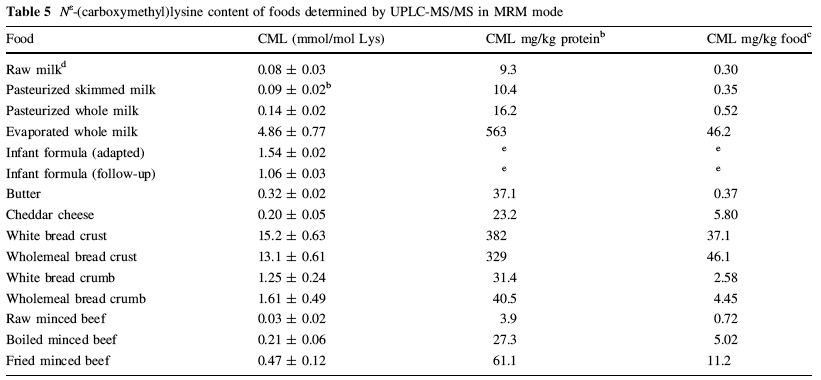All:
I've been meaning to post on this for a while. As already discussed, and put in
spreadsheet format by Edward last year, per the previous report,(2) using an assay of just ONE AGE (CML -- an important caveat, as glycotoxins are a highly complex and heterogeneous mix, with different underlying substrates and reaction chemistries), cooking fats and proteins together appeared to generate much higher levels of nasties than simply cooking carb, tho' one expects that mixing simpler carbs PLUS protein and fat (say, in a sugary- or even fruit-juice-sauced stirfry) is the worst of all.
One striking oddity in this list was a relaively high content of CML in olive oil, which should be chemically impossible, due to its lack of substrate (lysine). (1) in fact reports that "We could not detect CML in olive oil above the level present in the blank" and chalks the earlier report (2) down to experimental error. Moreover, after following a much more painstaking protocol to test a much more limited range of foods, white bread crust came out several times HIGHER in CML
per gram than does fried, minced beef, contrary to Vlassara's earlier findings. Here is their Table 5, where all the goods are:

While of course most people eat a whole slice of bread (if one eats the junk at all, of course), of which most of the mass is
lower in CML, I speculate that the crust may not be too much higher than much of the mass of a piece of toast.
Again, there are all kinds of other glycotoxins, and we don't know either how this compares to any other specific glycotoxins, nor WHICH glycotoxins are most injurious to health.
An easy rule is, of course, to avoid foods cooked at high temperatures and/or for extneded periods, rather than focussing on any ONE possible offender. Note that cooking WITH fats and sugars is both silly and largely unnecessary: eg, one can "stirfry" protein sources in water with spices, and then add sugary stuff and fats after turning off the heat and stirring up.
-Michael
1: Assar SH, Moloney C, Lima M, Magee R, Ames JM. Determination of
Nepsilon-(carboxymethyl)lysine in food systems by ultra performance liquid chromatography-mass spectrometry. Amino Acids. 2009 Feb;36(2):317-26. Epub 2008 Apr 4. PubMed PMID: 18389168.
2. J Am Diet Assoc. 2004 Aug;104(8):1287-91.
Advanced glycoxidation end products in commonly consumed foods.
Goldberg T, Cai W, Peppa M, Dardaine V, Baliga BS, Uribarri J, Vlassara H.
PMID: 15281050 [PubMed - indexed for MEDLINE]





















































